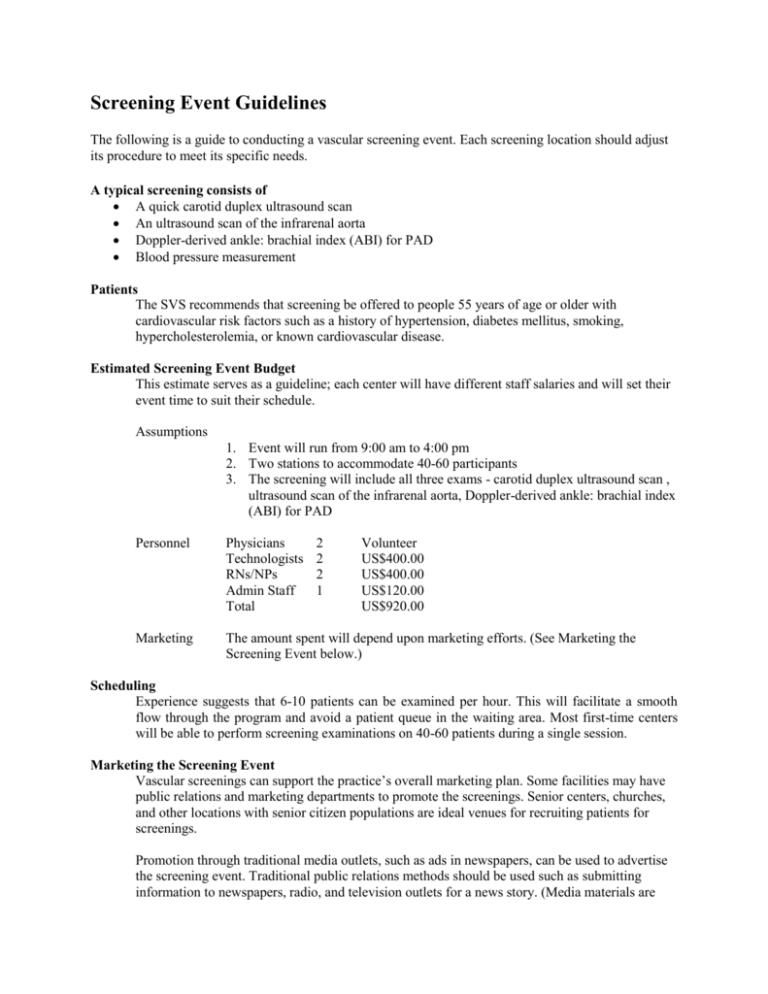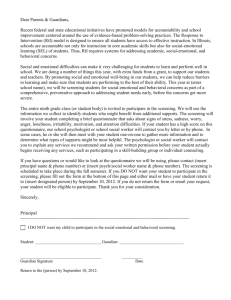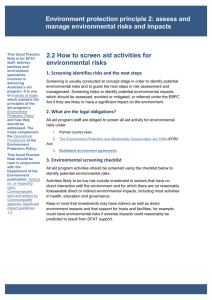
Screening Event Guidelines
The following is a guide to conducting a vascular screening event. Each screening location should adjust
its procedure to meet its specific needs.
A typical screening consists of
A quick carotid duplex ultrasound scan
An ultrasound scan of the infrarenal aorta
Doppler-derived ankle: brachial index (ABI) for PAD
Blood pressure measurement
Patients
The SVS recommends that screening be offered to people 55 years of age or older with
cardiovascular risk factors such as a history of hypertension, diabetes mellitus, smoking,
hypercholesterolemia, or known cardiovascular disease.
Estimated Screening Event Budget
This estimate serves as a guideline; each center will have different staff salaries and will set their
event time to suit their schedule.
Assumptions
1. Event will run from 9:00 am to 4:00 pm
2. Two stations to accommodate 40-60 participants
3. The screening will include all three exams - carotid duplex ultrasound scan ,
ultrasound scan of the infrarenal aorta, Doppler-derived ankle: brachial index
(ABI) for PAD
Personnel
Physicians
Technologists
RNs/NPs
Admin Staff
Total
2
2
2
1
Volunteer
US$400.00
US$400.00
US$120.00
US$920.00
Marketing
The amount spent will depend upon marketing efforts. (See Marketing the
Screening Event below.)
Scheduling
Experience suggests that 6-10 patients can be examined per hour. This will facilitate a smooth
flow through the program and avoid a patient queue in the waiting area. Most first-time centers
will be able to perform screening examinations on 40-60 patients during a single session.
Marketing the Screening Event
Vascular screenings can support the practice’s overall marketing plan. Some facilities may have
public relations and marketing departments to promote the screenings. Senior centers, churches,
and other locations with senior citizen populations are ideal venues for recruiting patients for
screenings.
Promotion through traditional media outlets, such as ads in newspapers, can be used to advertise
the screening event. Traditional public relations methods should be used such as submitting
information to newspapers, radio, and television outlets for a news story. (Media materials are
included in this toolkit.) These venues offer event calendars to list screening event dates. Because
vascular screenings are visual, television and newspaper reporters may be interested in taking
photos or video footage covering the screening, particularly if it is held on a weekend. This type
of coverage offers opportunities for interviews with vascular surgeons.
Online marketing should also be utilized. Include the information on your website. Share the
information through social media outlets as well.
This screening kit includes marketing templates:
Sample Press Release
SVS Position Statement on Screening
Facts about Peripheral Arterial Disease flyer
Facts about Carotid Artery Disease flyer
Facts about Abdominal Aortic Aneurysm flyer
Frequently Asked Questions About Vascular Disease and Screening flyer
Media Guidelines (provided separately)
Screening events should be listed on VascularWeb.org. Email the details: date, time, place to:
communications@vascularsociety.org.
Recommended Location Requirements
Vascular ultrasonographers/technologists to conduct the screening exams at accredited vascular
laboratories or by certified (RVT/RDMDS) vascular sonographers
Appropriate ultrasound equipment in a location suitable for testing
Physicians or other qualified vascular healthcare professionals to conduct exit interviews with
each participant
Patient Testing Forms
At the time of arrival, each patient should be checked in against the scheduling list. Depending on
the site’s requirements, patients will complete a standard notice of privacy compliant with HIPPA
regulations, a patient history form, and any additional forms required by your facility.
Upon completion of the screening, patients should meet with a medical professional to discuss the
results and receive a Vascular Report Card. If evidence of disease is found, patients should be
provided with an appropriate disease information flyer and complete a Primary Care Physician
Contact Authorization Form if the screening facility plans to contact the patient’s primary care
physician.
Screening forms contained in this kit:
Patient History Form
Vascular Report Card
Primary Care Physician Contact Authorization Form
So, your ultrasound screening indicates an Abdominal Aortic Aneurysm brochure
So, your ultrasound screening indicates Carotid Artery Disease brochure
So, your ultrasound screening indicates Peripheral Arterial Disease brochure
Screening Examinations
The following tests are typically performed during a vascular screening.
1.
Blood Pressure
Brachial systolic and diastolic blood pressures should be obtained. Some centers may elect (due
to time constraints) to perform Doppler-derived brachial systolic blood pressures alone. Systolic
blood pressure > 160mmHg and/or diastolic BP > 90 mmHg will be considered hypertension for
the purpose of the final patient information sheet to be distributed and discussed at the exit
interview.
2.
ABIs
Bilateral PT/DP Doppler-derived systolic pressures will be obtained and the highest systolic
pressure may be used to calculate the ABI in each leg. Many patients will be normal. To facilitate
exam efficiency in patients with normal pedal pulses or pedal Doppler signals, a single DP or PT
systolic pressure can be obtained.
It is recognized that ABIs obtained in this manner may be falsely elevated in diabetic patients. In
cases where severe distal vessel calcification is clinically obvious (e.g., ankle systolic pressure
>200mmHg, or ABI > 1.5 the screening center may either a) perform additional assessments, or b)
counsel the patient at the exit interview to obtain more formal testing.
3.
Quick Carotid Scan
The key to the efficiency of the screening (quick) carotid scan is vessel identification. Once the
ICA has been satisfactorily identified, a single "most representative" spectral waveforms with PSV
(and EDV if clinically indicated) are recorded. Screening centers may elect to preferentially use
color-shift evidence on color-Doppler images. Diagnosis will be < 50% stenosis, > 50% stenosis,
or >70–99% stenosis. (J Vasc Surg 1993; 17:152-159) (J Vasc Surg 1999; 29:986-994)
It is recognized that in a small number of cases, ICA occlusion may be identified. The transmission
of this information will be left to the discretion of the physician or other professionals conducting
the exit interview.
4. Aortic Scan
Aortic diameter > 3 cm is considered abnormal. The maximal transverse or AP diameter of the
infrarenal aorta should be recorded on the Vascular Report Card. The screening center may prefer
either longitudinal or transverse scanning, but only the area of maximal diameter should be
recorded.
Patient Exit Interviews
Patients should meet with a physician or other healthcare professional to discuss their screening
results. Provide a Vascular Report Card to document the findings. Patients with normal findings
may be encouraged to share the information with their physician for placement in their records.
Based upon experience, abnormal findings will be observed in 7-23 percent of cases. When
abnormal exams indicate evidence of disease, patients should be encouraged to report the findings
to their primary care physician. The findings should be recorded on Vascular Report Card.
Patients should be provided with the appropriate flyer during the exit interview:
So, your ultrasound screening indicates an Abdominal Aortic Aneurysm
So, your ultrasound screening indicates Peripheral Arterial Disease
So, your ultrasound screening indicates Carotid Artery Disease
Your practice may choose to contact the patient’s primary care physician in the case of abnormal
findings. Then, the patient must complete a Contact Authorization Form for the release of
medical information. Likewise, the screening facility should keep a copy of all forms provided to
the patient.
SVS Screening Event Toolkit (January 2011)
Copyright © 2011, Society for Vascular Surgery ®. All rights reserved.






